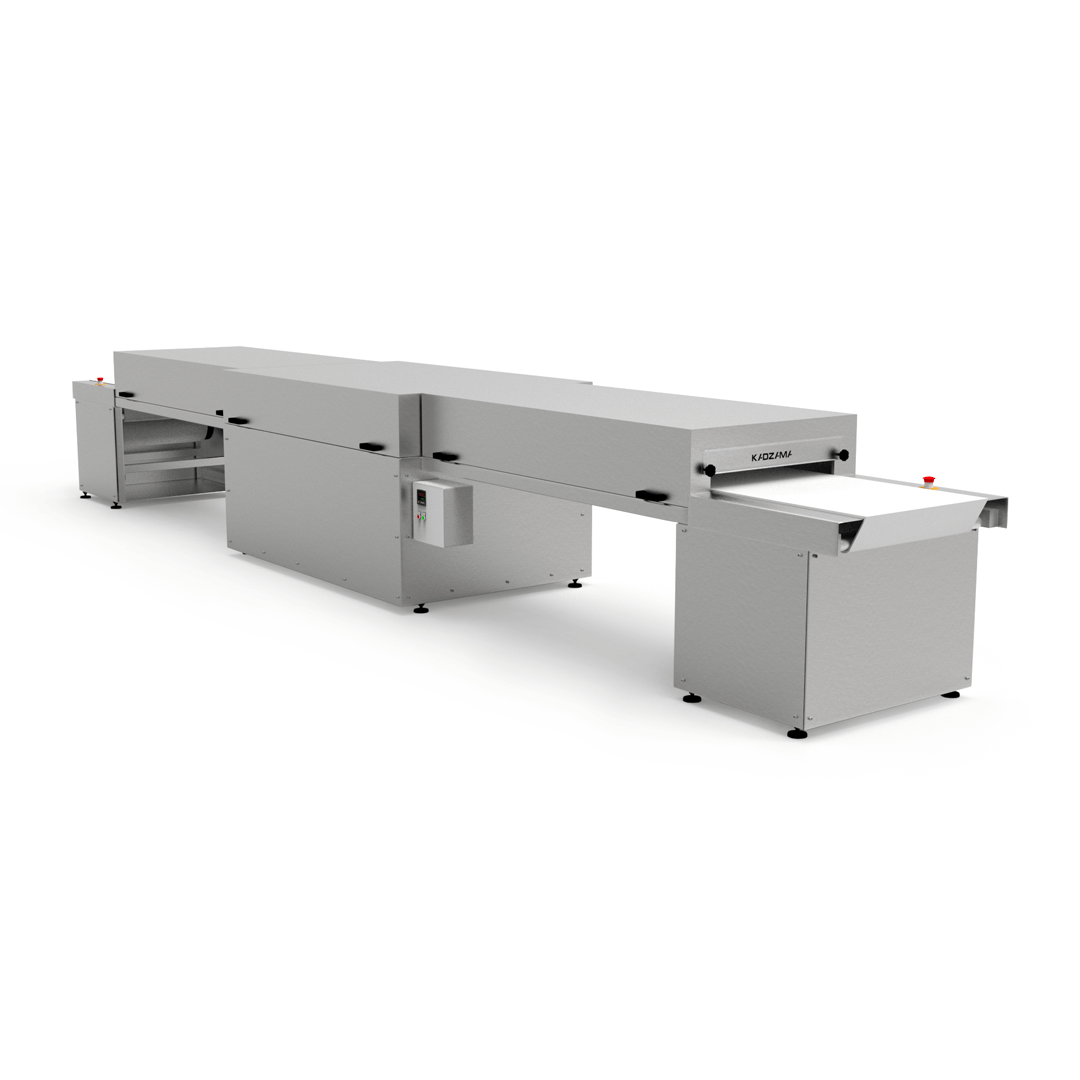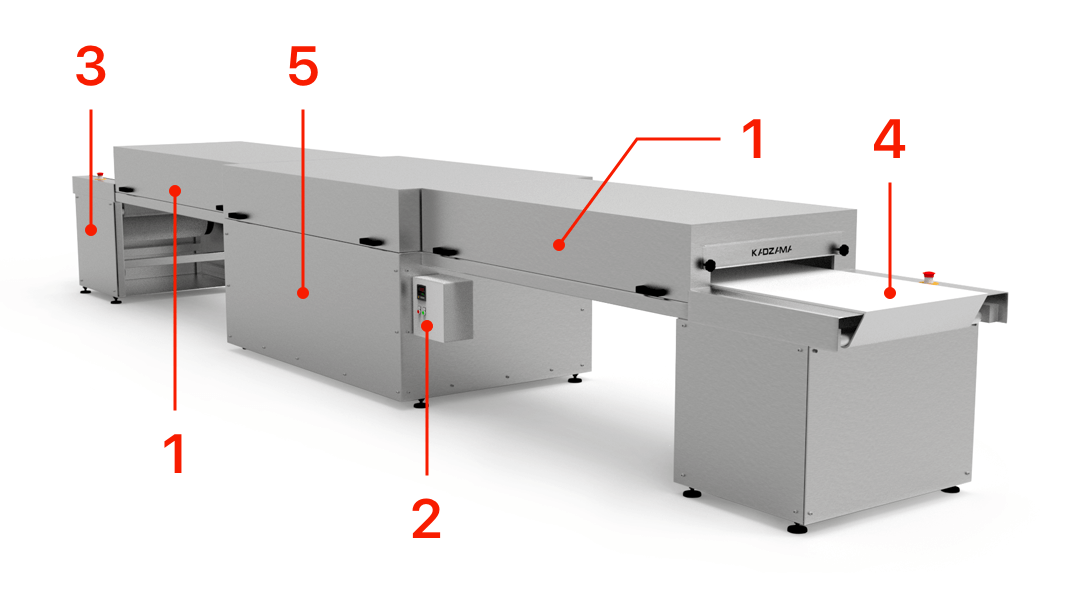-

The appearance of the product may differ from the illustrations presented in this manual.
Cooling tunnel 6 m
Manual
This manual is designed for study the main technical characteristics, operating principle and rules of technical operation of a cooling tunnel.
Before use carefully read the instructions below!
Improper use of the equipment can be a source of danger. By starting work with the device you confirm that you are fully acquainted with this manual and understood the rules of operation of the device.
KADZAMA Ltd appreciates your purchase and wishes you a pleasant work experience.
-
Purpose of the device
Cooling tunnel (hereinafter referred to as the tunnel) is designed for cooling confectionery products. All machine details contacting the product are made of materials approved for use. Subject to the requirements of the operating rules the machine is able to work stably in a full three-shift mode. Permissible time of continuous operation of the machine is 22 hours / day. The recommended time is 16 hours / day.
-
Specifications
Dimensional size (L x W x H), [mm] 7150 х 880 х 1120 Weight, [kg] 704 Belt speed, [m / min] 0 – 8 Power supply, [V] / [Hz] 380 / 50 Power intake, [kW / h] 4,5 Belt speed adjustment Yes Material Stainless steel AISI 304 Speed control Yes Temperature control accuracy +−1 Refrigerator temperature -5 to +12 ºC NOTE: The optimal temperature regime is 0 – +2 ºC. Working at lower temperatures is not recommended as it leads to rapid wear of the belt.
-
Configuration
Cooling tunnel — 1 pc.
Manual — 1 pc.
Warranty card — 1 pc.
-
Safety measures
4.1. The operation of the tunnel must be carried out in accordance with the instructions in this manual.
4.2. Only employees who have passed certification, studied the tunnel structure, this manual and also have the appropriate safety qualification group are allowed to work on the tunnel.
4.3. Any maintenance should be carried out when the tunnel is disconnected from the power supply!
4.4. Repair or disassembly may only be provided with the assistance of qualified personnel of KADZAMA Ltd.
4.5. The tunnel must not be operated if the following malfunctions occur:
Damage to the plug;
Grounding fault;
Smoke or a smell of burning insulation;
Noise, knocking, vibration.
Strictly forbidden:
Work with the frame skins removed and with the control door open;
Any alteration of the control scheme as well as unauthorized modification of the program code and unauthorized access to the control program.
4.6. Outside objects must not get into the cooling chamber.
4.7. Do not leave a working tunnel unattended.
-
Constructive elements description
Cooling tunnel is a flow-through refrigerating chamber with a moving conveyor belt inside. The tunnel has various modifications differing in the width of the conveyor belt and length.
Regardless of the modification, the tunnel consists of the following units:
1 — Tunnel section
2 — Control panel
3 — Belt tension unit
4 — Input unit
5 — Cooling block

NOTE: depending on the modification, the number of tunnel sections may vary.
The cooling chamber generally includes a cooling block (5) and tunnel sections (1).
The cooling block is made as a separate tunnel section and includes a refrigeration unit and an air cooler.
The tunnel sections are 650 mm wide. The length of the tunnel sections is the same regardless of the size. The total length of the tunnel is determined by the number of tunnel sections according to the modification. Increasing the number of sections of the cooling tunnel allows you to increase the speed of products passing inside the tunnel and productivity.
The inlet and outlet tunnel sections have adjustable shutters. The shutters are raised or lowered depending on the height of the items to be cooled. This reduces the loss of cold.
The input unit (4) performs the function of a conventional conveyor. It receives products for further cooling.
The belt tension unit (3) includes the drive mechanism of the belt conveyor and the tension mechanism itself. The drive of a belt is done by the motor reducer through a drum with a rubber covering. The belt tension is made by two pneumatic cylinders.
A scraper is installed at the exit of the belt to clean it.
Both the input and the tension unit have special protection against belt distortion during the conveyor working. To do this, they are equipped with special photo sensors that respond to the shift of the belt. When the sensors are triggered, the belt moving roller tilts, returning the belt to its original position (the belt tension system is equipped with pneumatic cylinders).
-
Before start
6.1. Installation and commissioning are carried out by employees or authorized representatives of KADZAMA on the basis of a contract, subject to the timely supply of energy and compressed air by the customer. At the request of the customer commissioning can be carried out at the manufacturer.
6.2. In the case of commissioning by the customer or third-party organizations, the customer loses the right to warranty service.
6.3. Commissioning includes installation, testing and setting of equipment, adaptation of the technological process to the conditions of the customer's production, training and certification of employees.
6.4. Setting the machine into work consists of checking the main machine parameters in accordance with this document and recording the check results. Based on the results of the inspection and the conclusion about the readiness of the machine for operation the «Act of acceptance of the machine into operation» is formed and a mark is placed in the «Certificate of Commissioning» regardless of the place of commissioning.
6.5. The act must be signed by a representative of the manufacturer. With no signature of the representative of the manufacturer at the «Act of acceptance of the machine into operation» warranty and post-warranty service is not carried out.
6.6. Recommended distances when placing the tunnel: from the wall to the back wall of the tunnel — at least 1 m, the service area from the front wall of the tunnel — at least 1.5 – 2 m.
-
Exploitation
7.1. Preparing the tunnel for work:
Make an external inspection of the actuators, make sure that the components are securely fastened and there are no external objects in the cooling chamber;
Set the tunnel and the refrigeration unit to the horizon by adjusting the supports;
Check for grounding;
Check the presence of condensate in the moisture separator and drain if found;
Turn on the power supply by setting the main switch to the «ON»;
Turn on the compressed air supply.
ATTENTION! The compressed air pressure controlling the belt tensioner is set on the pressure reducing valve. Precise recommendations for all cases of compressed air pressure adjustment cannot be given. It’s recommended to set the compressed air as low as possible, this helps to save the tunnel belt. Working nominal pressure 0.8 atm.
7.2. Production process
Confectionery products covered with chocolate mass or marmalade are loaded onto a belt conveyor passing in a tunnel, in which the chocolate mass is cooled by cold air coming from the refrigeration unit.
Refrigerated confectionery products arrive at the packaging table.
Conveyor belt movement is provided by an electromechanical drive.
-
Troubleshooting
List of possible malfunctions and their solutions.
8.1. Belt does not move.
Possible reasons:
No compressed air supply.
Solution: Provide compressed air supply.
Insufficient compressed air pressure in the belt tensioner.
Solution: Provide compressed air pressure in the belt tensioner at 2 atm.
Emergency stop button pressed.
Solution: Release the emergency stop button on the tunnel or machine.
8.2. Belt control is not working.
Possible reasons:
Photocell triggered.
Solution: Check for external objects in the cooling chamber.
Faulty pneumatic cylinders.
Solution: Replace pneumatic cylinders.
Dirty belt and rollers.
Solution: Clean the belt and rollers.
8.3. Loose fit of tunnel sections to each other.
Possible reasons:
Tunnel section hinges are not adjusted.
Solution: Adjust the hinges to ensure that the tunnel sections fit well.
Tunnel sections not aligned or leveled.
Solution: Align and level with screw supports.
-
Maintenance and care
9.1. The list of various types of maintenance and their frequency.
Daily before work:
External inspection of the state of protective grounding;
External inspection of mechanisms;
Checking for no external objects in the refrigerator;
Checking the availability of power and air supply;
Checking the presence of condensate in the moisture separator (perform with the compressor running);
Control of gearboxes for oil leakage;
Control the extraneous noise of gearboxes during work;
Check the reliability of gearboxes fastening;
Daily after work:
Washing and cleaning the tunnel
Once a month:
Belt drive chain lubrication
Once a quarter:
Lubrication of transfer case gears (LITHOL-24).
Once a year:
Change grease in bearing assemblies and transfer boxes (LITHOL-24).
Check the load-bearing structure for cracks and damage.
Carry out electrical wiring.
9.2. Pneumatic system maintenance.
Periodically check the oil level in the sight pipe.
Check the work of the compressed air distribution valve.
9.3. Filter maintenance (weekly).
Drain condensate from the filter by pressing the manual drain valve from bottom to top. Descent at short intervals if the condensate level approaches the red mark. This operation must be performed while supplying compressed air to the system (with the compressor running).
9.4. Grease tank service (monthly).
The sight glass on the reservoir shows the minimum and maximum oil levels. When the oil level reaches the minimum mark, fill the tank with oil. Before removing the tank, turn off the compressed air supply and empty the system of compressed air.
List of oils suitable for use (ISO VG 32):
Company Brand Agip EXIDIA 32 Api API CIS-32 EP ARCO TRUSLIDE 32 Barelli TIA/RO BK 32 Bellini WAY SI 32 BERGOLINE ENGINE K32 BP ENERGOL GHL 32 BRYTOL VAITAK 32, HYDRO D 32 Castrol MAGNA GC32 COMLUBE OLEOL HG32 efl HYGLISS 32 Esso FEBIS K32 EURAL TERCAL 32 FINA HYDRAN CIN 32 FUCHS RENOLIN MR 10 IGLEA FILETE VE 32 IP IP BANTIA OIL HG32 ISAOIL HWS 280 KLUBER LAMORA 32 LUBRA SLEDOL GC32 MILLOH TELEDINAX EP32 Mobil MOBIL VACUOLINE OIL 1405 OLEOBUTS OLIO DIN 32 OLIOFIAT RCS 32 Persian Oil AROIL S22 Q8 WAGNER 32 ROL LI 32-EP Shell TONNA OIL T32 SINOL SINOLUBE MB 3 TAMOIL TAMWAY OIL 32 TENNEX BARTON 11 TEXACO CLEARTEX D, RANDO OIL HD 32 TOTAL DROSERA MS 32 Vabriol METRA K 32, METRA T 32 VALVOLINE GES 32 Vanguard CO SPECIAL 32 VISCOL SIGNAL VL/U 32 (3) WEBER WEBER WEBSTICK 32 9.5. Tunnel washing
For sanitizing the tunnel water must meet all the hygienic requirements and quality control for drinking water.
ATTENTION! DO NOT EXPOSE THE INTERNAL SURFACES OF THE CONTROL UNIT WITH MOISTURE.
Washing and cleaning of the tunnel should be carried out 1 time per shift.
The tunnel must be defrosted before washing.
The tunnel has a self-defrosting system. It’s advisable to set the frequency of self-defrosting taking into account the shift work of production. The duration of defrosting is at least 30 minutes.
Tunnel washing includes the following:
Removing pallets and draining thawed water;
Cleaning the belt from product residues, washing with warm water no more than 40 ºC;
Cleaning the rollers under the belt (if they are dirty);
Cleaning the scraper from product residues;
Drying the tunnel with the covers open.
-
Warranty
The warranty period (as well as the terms of warranty service) are specified in the warranty card.
 Sending...
Sending...